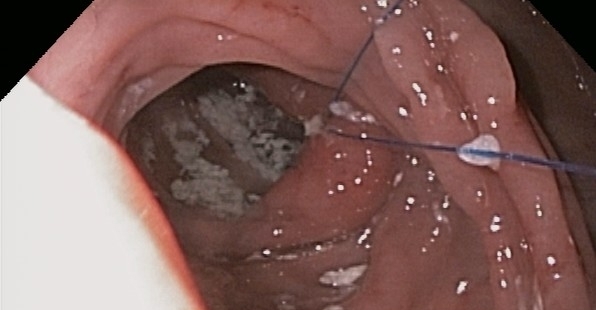Back to Program | 2010 Program and Abstracts Overview | 2010 Posters
Intermittent Bowel Obstruction After Gastric Bypass with Normal Imaging: Endoscopic Diagnosis and Treatment of Small Bowel Food Bolus Entangled in Sutures
Dan E. Azagury*1, Sohail N. Shaikh1, Marvin K. Ryou1, David B. Lautz2, Christopher C. Thompson1
1Division of Gastroenterology, Brigham & Women's Hospital, Boston, MA; 2Department of Surgery, Brigham and Women's Hospital, Boston, MA
Backround: Roux-en-Y gastric bypass (RYGB) is the most common surgical weight loss procedure in the US. Suture material is commonly seen at the gastrojejunal anastomosis and is often considered a normal finding. The presence of sutures, however, creates a potential web for entrapment of undigested food. We present a short series of 3 patients who experienced intermittent small bowel obstruction after RYGB due to the presence of a small bowel food bolus. Methods: Medical records were retrospectively reviewed for patients with history of RYGB and abdominal pain, and emergent enteroscopy, with foreign body removal. Results: Three patients with prior history of RYGB [3 months-8 years] presented to the emergency department with acute post-prandial emesis and epigastric pain. Additionally they related a 2-4 week history of intermittent pain, nausea, vomiting and wretching, especially after protein meals. One patient also complained of occasional hematemesis. Two of these patients had normal computed tomography of the abdomen. Endoscopic examination showed a normal esophagus and pouch, however in all 3 patients exposed suture was noted at the outlet. The suture extended into the roux limb under tension. One patient had an adjacent ulcer likely from repeated suture trauma. In all cases an undigested food bolus was found in the small bowel, entangled in a nest of suture line. The suture line was cut at its origin and traction placed on the suture to pull the bolus retrograde into the pouch. The bolus and suture were subsequently removed with a Roth net. In one case the large bolus was difficult to see until suture removal was attempted. Symptoms resolved following bolus removal in all cases. Conclusion: This series highlights a unique cause for common symptoms in the post bypass patient. Food bolus entrapment with partial bowel obstruction should be entertained in RYGB patients complaining of abdominal pain and with visible suture at the gastrojejunal anastomosis. Additionally those who undergo endoscopic evaluation for other indications should be considered for elective suture removal.
Image 1: Dangling suture is an abnormal finding.
Back to Program | 2010 Program and Abstracts Overview | 2010 Posters



